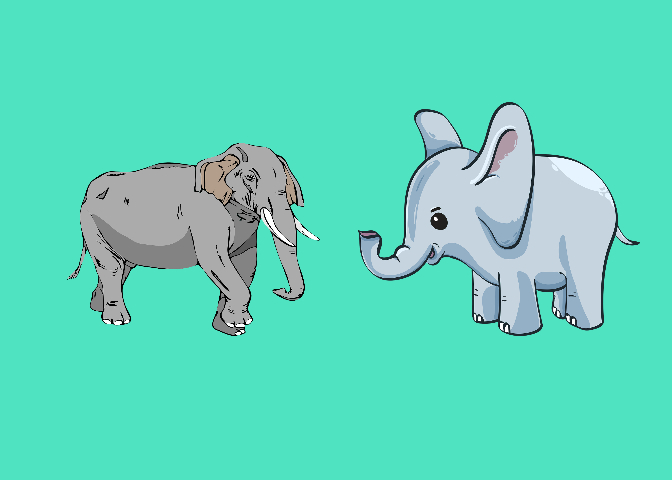100 Lines on Elephant for Class 1
Sure, here's the article about elephants in a kid-friendly language:
**Elephants: Amazing Giants of the Animal Kingdom**
Hey there, kids! Let's talk about elephants, the incredible giants of the animal kingdom. These big creatures are super interesting, and we're going to learn some cool facts about them!
**1. Elephants are the Biggest Land Animals**
First things first, elephants are the biggest animals on land. They're even larger than a big school bus! Imagine that! They're really, really huge.
**2. The Magical Trunk**
One of the most amazing things about elephants is their trunk. It's like a super long and bendy straw. They use it for so many things – to pick up food, drink water, and even say hello to their elephant friends!
**3. Elephant Families**
Elephants are not loners; they love being with their families. They live in groups called herds. The leader of the herd is usually a wise mommy elephant, called the matriarch.
**4. What's on the Menu?**
Now, what do these giant animals eat? Well, they are herbivores, which means they're vegetarian. They munch on yummy plants like leaves, grass, and juicy fruits they find in the jungle.
**5. We Must Protect Them**
Here's a very important thing, kids. Elephants are special, and they need our help to stay safe. Some people do bad things like poaching, which means hunting them for their precious ivory tusks. We must protect these gentle giants and their homes.
So, remember, elephants are not just big and gray – they're amazing animals that deserve our love and protection!
100 Lines on Elephant for class 1,2,3,4,5 class students and kids
1. Elephants are the world's largest land animals.
2. They have big ears that help them stay cool.
3. Elephants have long, flexible trunks.
4. They use their trunks to eat, drink, and play.
5. These gentle giants are herbivores.
6. Elephants eat lots of plants, like grass and leaves.
7. They live in warm places like Africa and Asia.
8. Elephants are social animals, living in herds.
9. The leader of an elephant herd is usually the oldest female.
10. Elephants can communicate with deep rumbles.
11. They also use body language to express themselves.
12. Tusks, made of ivory, are found in some elephants.
13. Unfortunately, poaching threatens elephants for their ivory.
14. Baby elephants are called calves.
15. Calves are born after a long pregnancy.
16. Elephants are known for their strong family bonds.
17. They care for their young and protect them.
18. Elephants have been used in some cultures for work.
19. Their strength makes them useful for heavy lifting.
20. In India, they're even considered sacred.
21. Elephants have thick, wrinkled skin.
22. Their skin can be gray or brown.
23. Elephants take dust baths to protect their skin.
24. They can run surprisingly fast for their size.
25. But they are most often seen walking slowly.
26. Elephants need lots of water to stay healthy.
27. They can drink up to 50 gallons a day.
28. Elephants have a long lifespan, up to 60 years.
29. Their intelligence is impressive.
30. Elephants have an excellent memory.
31. They can remember places and other elephants.
32. These amazing creatures are highly adaptable.
33. They can live in various habitats.
34. Sadly, elephants face threats from habitat loss.
35. Human activities harm their natural homes.
36. Conservation efforts are crucial to protect them.
37. Elephants are symbols of strength and wisdom.
38. They play important roles in their ecosystems.
39. Their grazing helps shape the landscape.
40. Elephants are also seed dispersers.
41. They eat fruit and spread seeds in their dung.
42. Many people admire and love elephants.
43. They inspire stories, art, and conservation.
44. Watching elephants in the wild is a thrill.
45. Tourists visit national parks to see them.
46. Poaching for ivory remains a major concern.
47. International bans aim to stop ivory trade.
48. Elephants are peaceful animals when not threatened.
49. They mostly eat, rest, and enjoy family time.
50. Playful young elephants can be quite entertaining.
51. Elephants often live near water sources.
52. They love to take baths and swim.
53. Elephants in zoos receive care and protection.
54. They play important roles in conservation programs.
55. Trained elephants have been in circuses.
56. But this practice is now controversial.
57. Elephant rides can also be problematic.
58. Concerns about animal welfare are growing.
59. Sanctuaries offer better environments for elephants.
60. They can live with dignity and safety there.
61. Education is key to elephant conservation.
62. People need to understand their needs and behavior.
63. Elephants face threats from climate change too.
64. Changing habitats affect their food and water.
65. Efforts are underway to reduce human-elephant conflict.
66. Elephants sometimes raid crops for food.
67. Protective measures can help both people and elephants.
68. Elephants are symbols of power in many cultures.
69. They appear in myths, folklore, and religions.
70. Ancient Egyptians revered the elephant.
71. African cultures often include elephants in stories.
72. Asian cultures consider them a sign of good luck.
73. Ivory trade has a long history of exploitation.
74. It drove many elephants to the brink of extinction.
75. The ban on ivory trade is a positive step.
76. But illegal trade still poses a threat.
77. Elephants need our continued protection.
78. Local communities play a vital role in conservation.
79. Coexistence is possible with proper planning.
80. Eco-tourism can benefit both elephants and people.
81. Responsible tourism supports their conservation.
82. Elephants teach us about the importance of empathy.
83. They mourn their dead and show emotions.
84. Studies show they can even understand human gestures.
85. The complex social bonds of elephants amaze scientists.
86. Researchers study their behavior and intelligence.
87. Conservation organizations work tirelessly to help.
88. They fund anti-poaching efforts and habitat protection.
89. Satellite tracking helps monitor elephant movements.
90. Technology aids in their conservation.
91. Elephants deserve a safe and secure future.
92. They are part of the Earth's precious biodiversity.
93. Every elephant's life is invaluable.
94. We must ensure they thrive for generations to come.
95. Let's celebrate these magnificent creatures.
96. Their presence enriches our world.
97. Together, we can be their voice and protector.
98. Join the fight to save elephants.
99. Support conservation efforts and spread awareness.
100. Together, we can make a difference in their survival.


.jpg)


